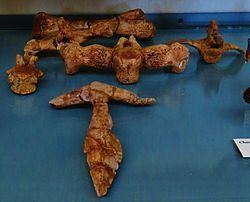Family Simoedosauridae Rank Genus | Class Sauropsida Phylum Chordata | |
 | ||
Similar | ||
Simoedosaurus is an extinct reptile known from the Paleocene of North America, Europe and western Asia, and a member of the Choristodera, a group of aquatic reptiles that lived in the Northern Hemisphere from the Jurassic to the early Cenozoic.
Contents
Phylogenetics
Though similar to and conspecific, Simoedosaurus is not closely related to the North American Champsosaurus, instead it appears to be most closely related to Tchoiria and Ikechosaurus from the Early Cretaceous of Asia. It therefore may represent a species that immigrated into North America from Asia in the wake of the Cretaceous-Tertiary mass extinction event, though the absence of choristoderes in the Late Cretaceous of Asia makes this merely a paleogeographical speculation.
Biology
Simoedosaurus was an aquatic predator, specialised to a fully aquatic lifestyle; though Champsosaurus might had still come ashore to lay eggs, ovovivipary is known in other choristoderes. It in particular possesses broader, stronger jaws than other longirostrine choristoderes, including its closest relatives, suggesting that it was capable of tackling larger prey. However, S. lindoei likely preferred softer prey than the North American species.
Simoedosaurus does occur in sites where aquatic crocodilians are present, including brevirostrine forms like Borealosuchus; the extent of competition between both groups, if there was any, is still unresolved.
Range
The earliest records of Simoedosaurus are from the Early Paleocene (Puercan Land Mammal Age) of Saskatchewan. It persisted until the Late Palaecene in North America, and has also been found in the Late Paleocene of France. The youngest remains seem to occur in the Eocene of Kazakhstan.
